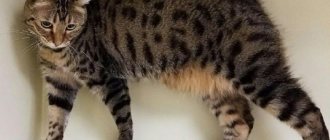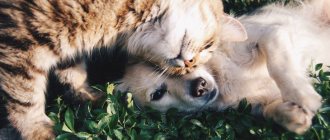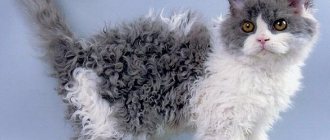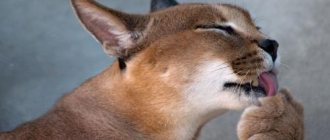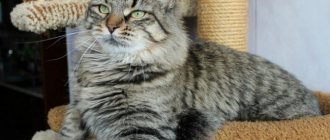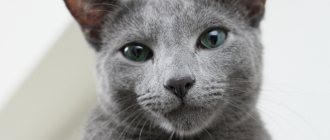Gray or, as they are usually called, blue cats are a fairly common type of color, which is characterized by a special nobility and a variety of unique shades. It is found both among purebred and ordinary domestic cats. It can be either uniform along the entire length of the fur or smoky - this means that the upper part of each hair of the animal is colored darker than the lower, and looks as if a dark veil has been thrown over the cat. The dark part of the hair can be even smaller, then the color is called “shaded” or “chinchilla”. What features does a blue cat have and what should you expect when inviting him into your home?
Story
The history of the smoky cat began quite recently, in 1975; the first kittens of the new breed appeared only at the end of 1980.
It took more than 10 years to finally breed the breed, but it was worth it. The first name of the overseas breed was “spotted mist”, which comes from the English word smoky. Later the name Australian Mist was assigned to the breed.
For a long time, the breed was recognized only in Australia, and therefore did not spread throughout the world. More recently, the smoky cat was identified as a separate breed in the international organization of felinologists and TICA.
The most interesting thing is that the smoky cat has no Australian predecessors; they were all brought to Australia. There have never been any felines on the mainland under natural conditions.
Description of the breed
Persian standard
There are currently 4 main types of Persian cats recognized:
- The classic type (British) is outdated, with a noticeable nose, the edge of which is located 5-6 mm below the edge of the inner corner of the eye.
- Modern type (short nose) - have an open look, the bridge of the nose is raised. Thanks to the wide eyes, the nasolacrimal ducts are not deformed, and the animal does not have a gloomy expression on its face.
- Extreme type (American) - the breed description is characterized by a short nose, round forehead, low-set ears, and straight-set eyes. The earlobe is almost at the same level with the inner corner of the eyes.
- Pig type (piggy) - the convexity of the skull is almost not pronounced, low weight, weak bones. This type is derived from the extreme.
Regardless of the type, the following reference characteristics are distinguished:
- Body: massive but compact; the chest and stomach are wide, rounded; the tail is proportionally short, very fluffy; average weight for females is 3-4 kg, for males 5-6 kg.
- Coat: silky, soft long hair covering the entire body; There are more than 200 species of Persian cat colors, including the graceful white Persian chinchilla.
- Head: muzzle flattened, almost flat, bone wide; forehead is rounded; the nose is short and raised.
- Eyes: wide-set, large and expressive; eye color can be green, blue, brown, and can also differ from one another (colorpoints with blue eyes and chinchillas with green should be noted separately); friendly look.
- Ears: usually small, low set, rounded tips; hidden behind abundant fur.
- Limbs: paws are fluffy, thick, proportionally short relative to the body.
- Life expectancy: extreme Persians live up to 15 years, ordinary modern Persians under normal conditions can live on average up to 20 years.
Top articles : Animals at risk of extinction due to climate change
Colors
- Solid (solid) - solid colors: white, black, blue, red (red), lilac, cream, chocolate. There are no patterns or streaks on the wool. Eye color is most often copper and dark orange or dark blue in white Persians.
- Bicolor is a combination of a primary color and white. The color of Persians is rare for Russian exhibitions, since breeding such a capricious spotted color requires a lot of effort. Bicolors should have at least 1/2 and no more than 2/3 white in color, with white spots on the head and tail desirable.
- Tabby - patterns on the fur: stripes, spots and marbles. Any basic coat color.
- Color point is the so-called Siamese coat color with dark spots on the face, paws and tail. Popular colors include brown, lilac, blue and black spots. Persian color-pointed cats were even identified as a separate breed - the Himalayan cat.
- Smoky is an amazing color in which each hair is conventionally divided into 2 color parts: a light base at the root and a dark color at the tip - tipping. At rest, the cat appears monochromatic, but when moving, the light undercoat becomes visible. Shades: black smoky, blue smoke, chocolate, tortoiseshell, lilac.
- Chinchilla - Golden and silver Persian chinchillas are now considered very popular and popular colors of the breed. Black tipping (the hair is colored only 1/8 with a dark tip) is evenly distributed on the back, sides, head and tail. The main color of gold is light apricot, while that of silver is pure white. A characteristic feature of chinchillas is the black rim around the eyes, nose and lips.
- Tortoiseshell is the color of Persian cats, in which there is a combination of two primary colors at once - red and black or their lightened analogues - cream and blue. This also includes the calico color - a combination of tortoiseshell and white.
Appearance
The smoky cat has an unusual appearance and is one of the short-haired felines. This cat cannot be called not beautiful, and now you will understand why. All representatives of this species are small in stature, however, they cannot be called small. Their body is medium in size with fairly well-developed muscles, which is clearly visible when the cat moves. The chest and shoulders also stand out well.
The large head is attached to the body with a medium-length neck. The muzzle is small and obtuse. The eyes are also medium in size. Their colors vary from yellow to green. The mustache is also small. The nose is medium with a noticeably prominent hollow. The ears are proportional to the head, stand erect, and their tops are rounded.
The tail is also of medium size in length and thickness. It is noteworthy that the tip of the tail is elegantly rounded. The stockiness of the animal is given by its medium-length, well-developed legs ending in small, soft oval paws. The toes are always tightly closed. The entire body of the animal is covered with uniform dark fur, which to the touch is similar to mink fur.
Breeds for which only gray coat color is acceptable
Among the varieties of cats, there are those that are characterized only by an ash-colored coat. These breeds include:
- ;
- chartreuse;
- Nibelung;
- korat
Russian blue
Representatives of this breed are medium in size and have a slender build. But the main feature of Russian blue cats is considered to be their unique color, emphasizing the bright green color of their eyes. Their coat has silver ticking, which gives their short, thick coat a snowy effect.
According to the standard, a Russian Blue cat must have uniform fur without yellowness, streaks or inclusions.
Chartreuse
These are large, well-built cats with well-developed muscles, a cheeky muzzle, a round head and small ears. Their soft, plush coat with a thick undercoat is colored only a uniform gray.
Blue cats' irises can be dark orange or bright yellow. And each chartreuse paw has soft gray-blue pads.
Nibelung
This is a long-haired variety of Russian Blue cats that has inherited all the characteristics of its ancestors with the exception of the structure and length of the fur. The Nibelungs got their name (translated from German as “creature of fog”) due to the unique color of their fur coat.
The thin silky coat of the breed is colored blue, in harmony with the green eyes. According to the standard, these gray cats have weak ticking.
Korat
These elegant gray cats were brought to Europe from northern Thailand over a hundred years ago and were long considered a cull of the Siamese. Korats are medium in size, flexible muscles and have an unusual heart-shaped head.
Best articles: Characteristics, types and stages of exocytosis
The hallmark of the breed is its olive-green eyes and short, silky coat, the color of which varies from blue-gray to lavender.
Character
The smoky cat breed has a “golden” character and a quiet melodious voice. They are very friendly towards everyone around them (they even get along with dogs if introduced correctly). As a rule, they choose one family member to whom they express their devotion and love: they walk behind him, love to sit in his arms and purr with pleasure.
Judging by the reviews of the owners, these cats have different attitudes towards children. You need to know that the latter do not tolerate noise: loud screams, scandals. In such situations, they try to hide, but can bravely engage in hand-to-hand combat with the source of noise. Therefore, if the child is very capricious, then you should keep them away from each other. But in general, the smoky cat breed is characterized by peacefulness, innate good manners and tender affection for the owner. She is not intrusive and will not scream loudly when hungry. By running alternately to the owner, the bowl and the refrigerator (or other object in which her food is stored), she will make it clear that she is hungry.
Chartreuse
This is a large, strong, muscular cat, with a rounded head, small ears, large expressive eyes of yellow or copper color, and a pleasant, friendly expression on its cheeky face. The coat of the Chartreuse (exclusively blue) is short and very thick. Chartreux are naturally trained, calm, observant and affectionate. As a rule, they choose their favorite from the family, but find a common language with everyone.
This breed was bred on the basis of cats that appeared on the territory of France during the Middle Ages - it is generally believed that the Crusaders brought them with them. Their homeland is the mountains of Turkey and Iran with very harsh living conditions, which explains their extremely thick fur and excellent hunting skills. This is one of the oldest European cat breeds, the pride of French felinology, it was bred at the beginning of the last century.
Content Features
Gray cats for the most part have strong immunity and tolerate significant drops in temperature well. You can feed them both natural food and industrial feed - the main thing is that the food is balanced. Don’t forget about timely vaccinations and regular hygiene procedures: ear cleaning, dental examination and claw care.
Wool
- Ancient dog breeds
- Dog's sense of smell
- Maine Coon
- Domestic iguana
- How much does a raccoon cost?
- Interesting facts about cats
If your pet is a show specimen, then it should be limited in many ways, for example, walks in clear weather should be reduced to a minimum, not allowed outside during rain or snow, and a more careful approach to the preparation of the diet. First of all, this is necessary for the beauty of his coat, since the ash shades will remain ideal only if a certain menu is followed (with a low iodine content). As for direct sunlight and high humidity, they can provoke the appearance of red spots. As a result, this will certainly affect the assessment of the beauty of a purebred animal.
In general, such cats are considered long-lived, and with proper care they will delight you with their company for 14-16 years. Pay attention to your pet's nutrition, do not forget to care for her luxurious gray coat and always show sincerity towards her. And she, in turn, will be your devoted friend and reliable companion.
Maine Coon
The Gulliver cat cannot be confused with any other breed. A long body, high strong legs, powerful paws, a luxurious tail, lynx tufts on the tips of the ears and, of course, an indescribable expression on the face, serious and good-natured at the same time. The Maine Coon's coat is not very thick, but it is quite long. Breed standards allow many colors. And there is no doubt that a blue Maine Coon (like any other) looks very stylish! These are smart, playful, sociable, but unobtrusive cats.
The Maine Coon is one of the most famous, recognizable and popular breeds bred by American breeders. However, selection, in the modern sense, began only in the middle of the last century. Meanwhile, evidence of the existence of these cats dates back to the middle of the 20th century: the first known Maine Coon made a splash at a country fair, striking the public with its impressive size and shaggy appearance.
Health
According to the breeders, the Australian Mist has good health and is not affected by diseases inherent in other breeds. One can only envy their immune system.
Of course, one cannot overlook the fact that the conditions in which a smoky cat is kept also affect its life expectancy and health. And a wonderful gene pool will not help here.
The main thing is that you need to adhere to some rules:
- balanced diet;
- the quantity and quality of water and food must be normal;
- maintaining a healthy indoor microclimate.
Additionally, there is no need to take the haze outside, since it spends its energy playing in the apartment. Please note that all vitamins and minerals must be present in the diet. In this case, the owner will be able to avoid serious health problems for the smoky cat. It should be noted that the Australian Mist is prone to obesity (look at the photos of overweight cats), so the owner should pay attention to the portion size.
British shorthair and longhair
It would be unforgivable to forget about the Briton - with his magnificent, thick double coat of “untwisted” blue color and amber eyes! Most cat lovers perceive them in this color variation. Meanwhile, this massive, but compact, well-proportioned cat with an important expression on her cheeky face can be of almost any color - no less spectacular than blue!
The British are one of the most famous and popular breeds bred in the UK. Persians were involved in selection (this was required after World War II, when the breed was on the verge of extinction). The long Persian coat gene has been making itself felt for many generations. Long-haired kittens were not born very rarely, but were considered a breed defect. However, they were beautiful, and enthusiasts decided to form a standard for a new breed.
Blue and smoky colors are allowed by many breed standards, but are rare in most cases. In addition, these are one of the most capricious colors of a cat's fur coat - if not the most capricious. The fact is that the quality of color is affected not only by age (in all older animals the fur coat somewhat loses its beauty), but also by sunlight, as well as nutrition. Intensely colored food gives it a dirty tint.
Source
What to feed your Australian Mist
Despite the fact that smoky cats are not picky about food, you cannot feed them exclusively dry ready-made food. It is acceptable to add them to broth or porridge. Do not give your cat hollow bones; mists cannot handle them and there is a risk of injury. Australians are not at risk of poisoning, because... they will never eat food that smells stale. Changing food or water can cause diarrhea in your cat. It’s not scary, after getting used to the new product everything will work out.
The frequency of feeding depends on the age of the animal. Kittens 2-3 months old are fed two, if possible three times a day. It is recommended to give rice, buckwheat, oatmeal with the addition of finely chopped chicken, beef or offal. Every other day, it is recommended to offer fermented milk products and boiled fish. Once the cat reaches one year, you can switch to two meals a day.
Nibelung
Nibelungs are called the long-haired version of the Russian Blue, since representatives of this breed were actively involved in their selection. Indeed, their appearance is similar, and the tips of the Nibelung's hairs also have silver tipping. But there are also differences. First of all, it is long (more precisely, semi-long) thick fur, more developed muscles, and not such a bright eye color. This is a smart, good-natured and affectionate cat.
Despite the obvious relationship, the “founding fathers” of the breed were ordinary mongrel cats that were born in the United States in the 80s of the last century. Their owner logically reasoned that her unusual animals were worthy of the attention of the geneticists of the TICA felinological system. Indeed, she managed to interest specialists, and a decision was made to create a new breed. It received a beautiful legendary name for two reasons. The word “Nebel” means “fog” in German, which suits her appearance very well. And of course, in honor of the famous German epic.
Signs associated with gray cats
You might be pleased to know that if a gray cat crosses your path, you don’t need to be scared, spit, or change direction. Just the opposite! Such a meeting promises you good luck on your journey, especially if you say at the same time: “A gray cat is a happy path.”
Very often, frankly mystical properties were attributed to animals of this color:
- It is believed that a gray cat endows its owner with beauty and harmony, both physical and mental.
- Such cats perfectly protect the house from troubles and brownies.
- Their presence is very useful for pregnant women.
- Gray cats with green eyes, according to popular belief, are endowed with the ability to absorb lunar energy and heal sick people with it.
If a gray cat comes into your dream, this is a warning of impending trouble. Just don’t scold her for it! - after all, she, on the contrary, acted as a guardian angel, giving you the opportunity to prepare for the blow of fate or even avoid it.
The influence of genetics on cat color
There are two main colors responsible for variations in the colors of a cat’s fur coat:
- black;
- red.
Each color is formed due to a complex pigment - melanin, which is divided into two chemical subtypes:
- zumelanin (gene B) - is responsible for the black color and its derivatives;
- pheomelanin (gene A) - produces all shades of red.
The genes responsible for producing red (O - dominant) or black (o - recessive) offspring are located on the X chromosome. The color of a kitten's fur directly depends on the gender of the parents:
- cats have one X chromosome and one Y chromosome (XY);
- Cats have two X chromosomes (XX).
The kitten inherits one of the chromosomes from each parent. From the mother it will always be X, and from the father X or Y.
Just like in humans, female cats have a set of XX chromosomes, and males have XY chromosomes.
Two cat chromosomes (XX) are responsible for three basic colors:
- OO - red;
- oo - black;
- Oo - tortoiseshell (red-black).
The color of cats directly depends on which gene is carried by the only X chromosome of the parent - O or o. If there is an “O” gene on the only X chromosome of a cat, the cat will be red, but if there is an “o”, it will be black. Tortoiseshell cats appear only in the case of gene mutations and cannot have offspring.
If the parent X chromosome carries the O gene, the cat will be red, and if O, the cat will be black.
The white color stands out separately (although it is not a color at all, but rather its absence). If a cat is not an albino, then it is a carrier of some color.
White spots merged together form a kind of camouflage suit, under which any color can be hidden. You can find out which color a white pet is a carrier of by looking at its offspring.
Genetics of gray color
In felinology, the gray color of a cat's coat is called blue. In fact, the blue color is a bleached black. In gray pets, the dominant black gene B (Black) is diluted by the recessive light gene d. The black pigment (zumelanin), under the influence of the light gene, is not distributed evenly in the hair, but as if sticking together into lumps. The white spaces between the clumped zumelanin granules create a lightening effect. The less black pigment in the hair, the lighter the color of the cat.
Purchase
The limited number of representatives of the breed makes these smoky cats increasingly desirable for many. You should be extremely careful when purchasing a pet. It is very difficult to find them in nurseries; kittens are waited for several months. It is impossible to acquire such a treasure by hand.
What to pay attention to
You need to purchase an animal from nurseries that specialize in breeding and have a license . Kittens from there are sold already litter box trained, trained in basic hygiene rules and vaccinated. Not only color, but also character, late puberty, loyalty and lack of aggression make cats of this breed the best for living in a family with children.
Therefore, you should not take risks and purchase exotic kittens from unverified sellers who, at best, will pass off a culling (sterilized babies with defects - they cost several thousand rubles cheaper) or a half-breed as a smoky Australian Mist.
Australian Mist breed price
Only a few catteries breed Mist cats, most of them are located in Europe. In Russia and the countries of the former USSR, there are no such nurseries and breeders who have the right to breed mysts.
The price for these cats starts from 400 dollars (in Russia from 25 thousand rubles). A person who wants to sell a kitten must have documents for a baby or an adult animal, vaccination certificates, and a very detailed pedigree.
Russian blue
A slender, muscular cat of medium size, on high legs, with a proportional wedge-shaped head and high-set ears. The calling card of the breed is its unique color, blue with silver tipping (lightened hair tips). It feels like the cat's coat is dusted with snow. She looks absolutely stunning with bright green eyes! The coat of Russian Blues is short and very thick - according to the standard, the hairs should be located vertically to the skin.
The history of the breed (like many other old breeds) is complex and somewhat confusing. But it is known that neither Russians nor modern Russian breeders have anything to do with its creation. These cats were bred at the beginning of the last century in Great Britain - based on animals imported from Arkhangelsk. At least that's what the most common version says. However, cats from other regions and representatives of other breeds were also involved in selection.
Owner reviews
You can leave your reviews about the Australian Mist breed, other users will be interested: In our country, the Austrian Mist is quite difficult to find. While an incredibly large number of reviews can be found about other breeds, information from Australian Mist owners is minimal. The breed is common in Australia, the USA, and some European countries.
Marina:
“I’m proud of my beauty, because she is truly exclusive. They brought it to me from Australia as a birthday present. The best friend. Loyal, affectionate, understanding, loving. He doesn’t go outside and doesn’t suffer from it. He limits himself to going to the balcony and watching what is happening at the window. For 3 years I have not been sick with anything, my health is good, and problems with the gastrointestinal tract occasionally occur. This happens when changing food. Then the body gets used to it, everything is fine.”
Veronica:
“I’ve been waiting for the Australian Mist for six months. A handsome lilac-colored man came to see me. I immediately fell in love with her big, smart eyes. A creature of the kindest disposition. Living soft toy. The little niece is simply crazy about him. And he is not indifferent to her. He understands perfectly. He doesn’t climb on tables, he was already trained to the tray, all that was left was to show him the place where to look for him. Funny, active. I went everywhere, even got into a bag of flour. Silent, meows occasionally. You won't hear his voice. We also pleased our mother.”
Video
Javanese
The longhaired breed is one of the varieties of domestic cats. By their nature, they are also mischievous, so they should not be left without toys and unattended. They themselves are friendly and affectionate, but despite this they are very stubborn, get used to their owners and have a hard time with separation.
Their health is not the best, they need to be protected and given a lot of attention to care. An interesting feature is the unique structure of the wool, to which people are not allergic. One can note very beautiful eyes, but despite this, strabismus is common among this breed.
Javanese
Turkish Angora
A specially bred long-haired cat breed is now actively gaining popularity among lovers of blue-eyed pets. Many years of complex and painstaking work by breeders has led to such a successful result. This breed has many colors, but meeting a snow-white cat, of which there used to be many, is now very rare.
They themselves are small, of medium size, have a slender physique, in which one can notice grace, the limbs and tail are long, supposedly emphasizing the elegance of the silhouette. Smart, sociable, friendly - that's all about them. They do not leave their owner for a second, as they need attention; because of this feature, they have a hard time experiencing loneliness.
Turkish Angora
Khao-mani
This breed can be considered legendary, because the history of its creation has passed many years and, as we can see, its demand has not fallen to this day, on the contrary, it is gaining popularity. In her homeland, Thailand, they believe that such a cat brings good luck and prosperity to the house.
Representatives of this breed are characterized by an unusual appearance, especially their eyes, they are like their calling card. Among such cats, heterochromia is widespread, when the color of the iris of the eyes is uneven, and sometimes the eyes can be completely different colors.
They are distinguished by a slender and muscular physique, and the tight-fitting coat seems to emphasize all the advantages of the silhouette. They are also characterized by elegance and grace in all movements.
They are affectionate and friendly, quickly get used to people, so they have a hard time experiencing separation and loneliness. These are excellent companions for both children and a wide variety of pets. By nature they are active, cheerful, playful and curious.
Khao-mani
